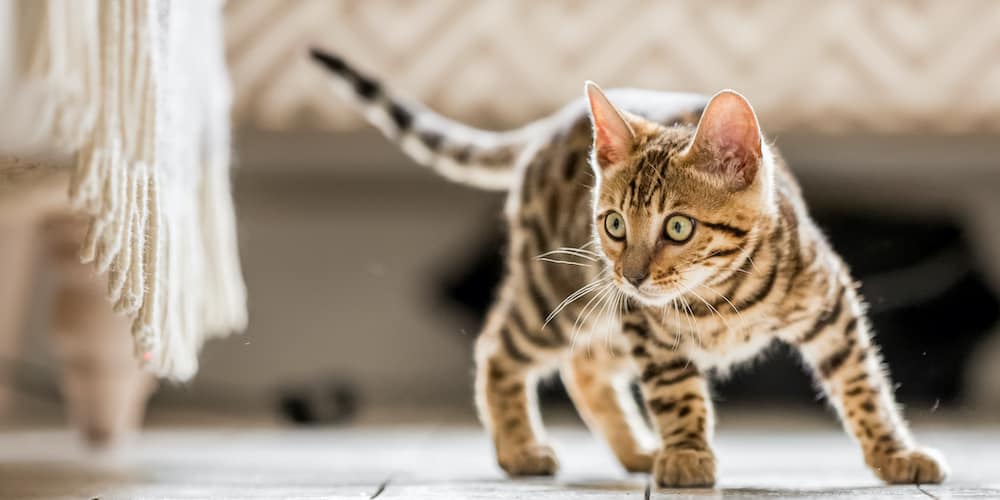First, it is important to define the word “kitten”. Behind this term commonly used by cat owners actually lie multiple stages of its life.
The growth of a kitten is not the same between its birth and reaching adulthood. That’s why it’s important that your young companion’s diet meets their needs at each stage of their life.
We distinguish 4 stages as follows: birth, from birth to weaning, weaning, and from weaning to adulthood.
Your kitten’s diet therefore depends on its age but also on several factors. If you encounter any difficulty, remember that your veterinarian can help you create a nutrition plan that best meets its needs.
📚 Also read | The best cat kibbles according to a veterinarian’s criteria
What should a newborn kitten eat?
The needs of the kitten at birth
Before birth, the growth of your little kitten is already influenced by several factors. The mother’s diet, the number of kittens in the litter, and the genetics of the parents are part of the aspects that come into play.
It is during gestation that the kitten’s growth peak occurs. After birth, other factors intervene in the nutrition of the newborn kitten, such as the course of delivery or birthing, for example.
Mother’s milk
From birth, a kitten needs its mother’s milk. It’s the best food for it! If, for several reasons, your kitten cannot drink maternal milk, it then becomes necessary to feed it with kitten formula milk.
If you need to bottle-feed your kitten, the number of meals is very important during its first week of life. You must then feed it with 7 bottles a day. This figure then gradually decreases over the weeks.
Your veterinarian can help you calculate the exact amount of milk to give it each day by preparing a nutrition plan for your little feline.
To learn more, don’t hesitate to consult the nutritional recommendations for cats at each stage of their life.
How to feed a one-month-old kitten?
Weighing your kitten
During the first months of life, your kitten’s growth is linear. I recommend therefore weighing it regularly to monitor the proper evolution of its weight.
Keep in mind that a newborn kitten’s weight doubles after a week. It then doubles between 2 and 4 weeks of age and again between 4 and 8 weeks of age.
The quality of the mother’s milk plays an important role during this period. Also, I recommend weighing your kittens on the first day of their life, then after one week and finally after two weeks of age.
Any anomaly should be reported to your veterinarian, for example, if your kitten isn’t gaining weight or if it is losing weight.
Mother’s diet
The mother should have a diet suitable for nursing cats. This diet meets not only her own needs but also the nutritional requirements of the kittens that nurse from her milk.
Remember that your kitten’s diet must be balanced! Any imbalance can lead to health problems due to deficiencies, such as bone growth disorders, for example.
What to give the kitten during weaning?
When does weaning occur?
Weaning corresponds to the moment when kittens begin to become independent, not only nutritionally but also behaviorally.
Weaning is a gradual process that begins around 4 weeks of age and ends around 8 to 10 weeks of age. Your kitten thus gradually consumes solid foods.
Néanmoins, si votre chaton n’a pas consommé le lait de sa mère et a été biberonné, retenez que le sevrage commence à sa 6ème semaine de vie.
Gradual transition to solid food
During weaning, your kitten consumes both maternal milk and solid food. The goal is that at the end of weaning, your kitten eats only solid food independently.
At the beginning, I recommend giving it a wet solid food, always for kittens, and mixing it with the milky diet. By the end of weaning, your kitten should ideally have a diversified diet, meaning a mixed one, both wet and dry.
A quality weaning is necessary for your kitten to smoothly transition to its adult cat life.

How to feed a kitten after weaning?
Choosing the Right Diet
After weaning, your kitten generally maintains the solid diet it gradually acquired during the weaning period.
From weaning to adulthood, its growth depends on its diet, physical exercise, and health status.
A diet for weaned kittens is essential to meet their needs. In adulthood, your feline’s growth slows down, allowing you to switch to adult cat food after a transitional feeding phase.
Care in Case of Neutering
Nevertheless, dietary changes may be necessary during this final phase. This is notably true if you spay or neuter your kitten.
Indeed, such an operation has its repercussions, as the energy needs of a neutered kitten decrease.
After neutering, your kitten should receive less energy to prevent weight gain. I recommend giving several small meals throughout the day, with food adapted to its new condition.
My Tips for Neutered Kittens
If your kitten seems
De plus, vous pouvez aussi rajouter des courgettes cuites dans sa ration. Elles permettent de remplir l’estomac mais ont aussi l’avantage d’être riches en eau.
Quoi qu’il en soit, la ration de votre chaton stérilisé doit être équilibrée pour répondre à ses besoins. N’hésitez pas à en parler à votre vétérinaire qui peut vous aider dans ce choix.
Sources et études scientifiques
Gwenaël Outters, « L’alimentation du chaton répond à des règles précises », La Semaine Vétérinaire, n° 1446, 15/04/2011, p. 42 et 43.
Marianne Diez et al., « Alimentation du chaton pendant la période de croissance de 2 à 6 mois », Le Point Vétérinaire, Bonnes pratiques en pédiatrie canine et féline, 2019, p. 24-28.
Jessica Quimby et al., « 2021 AAHA/AAFP Feline Life Stage Guidelines », Journal of Feline Medicine and Surgery, volume 23, mars 2021, p. 211-233.



